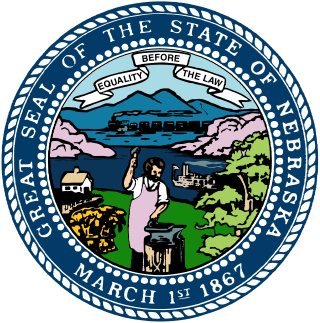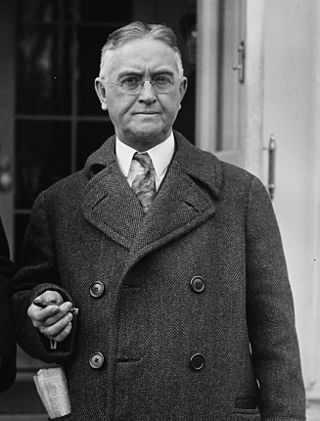
Charles Wayland Bryan was an American businessman and politician who served as the 20th and 23rd Governor of Nebraska, and Mayor of Lincoln, Nebraska, and was the Democratic nominee for Vice President in 1924. He was the younger brother of William Jennings Bryan.

The 2014 United States Senate election in Nebraska took place on November 4, 2014. Incumbent Republican Senator Mike Johanns did not run for re-election to a second term. Republican nominee Ben Sasse defeated Democratic nominee David Domina to succeed him.

The 1946 Nebraska gubernatorial election was held on November 5, 1946, and featured former school superintendent and newspaper publisher Val Peterson, a Republican, defeating Democratic nominee, state Senator Frank Sorrell.

The 1942 Nebraska gubernatorial election was held on November 3, 1942. It featured incumbent Governor Dwight Griswold, a Republican, defeating Democratic nominee, former Governor Charles W. Bryan, to win a second two-year term in office.

The 1940 Nebraska gubernatorial election was held on November 5, 1940, and featured newspaper publisher and former state legislator Dwight Griswold, a Republican, defeating Democratic nominee, former U.S. Representative Terry Carpenter. Griswold became the first Republican to win the governorship since 1928.

The 1938 Nebraska gubernatorial election was held on November 8, 1938, and featured incumbent Governor Robert L. Cochran, a Democrat, defeating Republican nominee, Speaker of the state legislature Charles J. Warner, as well as former Democratic Governor Charles W. Bryan, who ran as an Independent, to win a third and final two-year term in office.

The 1934 Nebraska gubernatorial election was held on November 6, 1934, and featured state engineer Robert L. Cochran, a Democrat, defeating Republican nominee, newspaper publisher and former state legislator Dwight Griswold.

The 1932 Nebraska gubernatorial election was held on November 8, 1932, and featured incumbent Governor Charles W. Bryan, a Democrat, defeating Republican nominee, newspaper publisher and former state legislator Dwight Griswold, to win a third and final two-year, non-consecutive term in office.

The 1926 Nebraska gubernatorial election was held on November 2, 1926, and featured incumbent Governor Adam McMullen, a Republican, narrowly defeating Democratic nominee, former Governor Charles W. Bryan, to win a second and final two-year term in office.

The 1924 Nebraska gubernatorial election was held on November 4, 1924, and featured former state Senator Adam McMullen, a Republican, defeating Democratic nominee, former state Representative John N. Norton, and Progressive nominee, Omaha City Commissioner Dan B. Butler.

The 1922 Nebraska gubernatorial election was held on November 7, 1922, and featured former Mayor of Lincoln Charles W. Bryan, a Democrat, defeating Republican nominee, state Senator Charles H. Randall.

The 1918 Nebraska gubernatorial election was held on November 5, 1918, and featured former lieutenant governor Samuel R. McKelvie, a Republican, defeating incumbent Democratic governor, Keith Neville.

The 2022 Nebraska gubernatorial election took place on November 8, 2022, to elect the next governor of Nebraska. Incumbent Republican governor Pete Ricketts was term-limited and unable to seek a third term. In the general election, Republican Jim Pillen won the gubernatorial election by a 23-point margin.

The 2022 Nebraska State Legislature elections took place as part of the biennial United States elections. Nebraska voters elected state senators in the 24 even-numbered seats of the 49 legislative districts in the Nebraska Unicameral as well as in a special election for the 31st District. State senators serve four-year terms in the unicameral Nebraska Legislature.

Charles Wesley Herbster is an American agribusiness executive, cattle producer, political donor, and politician. He was an agriculture advisor and chairman of Donald Trump's agriculture and rural advisory committee during Trump's 2020 presidential campaign. Herbster also ran unsuccessfully for the Republican nomination for Governor of Nebraska in 2014 and 2022.

The 1926 Nebraska lieutenant gubernatorial election was held on November 2, 1926, and featured incumbent Nebraska Lieutenant Governor George A. Williams, a Republican, defeating Democratic nominee Frank A. Dutton as well as Progressive nominee Lloyd H. Huffman.

The 1924 Nebraska lieutenant gubernatorial election was held on November 4, 1924, and featured Republican nominee George A. Williams defeating Democratic nominee P. J. Mullin as well as Progressive nominee Granville Hummer and Prohibition nominee J. F. Webster. Incumbent Nebraska Lieutenant Governor Fred G. Johnson, a Republican, chose not to seek reelection to the office of lieutenant governor in order to challenge George W. Norris for the Republican nomination for US Senate from Nebraska.

The 1922 Nebraska lieutenant gubernatorial election was held on November 7, 1922, and featured Republican nominee Fred G. Johnson defeating Democratic nominee P. J. Mullin as well as Progressive nominee T. J. Ellsberry. Incumbent Nebraska Lieutenant Governor Pelham A. Barrows, a Republican, chose not to seek reelection to the office of lieutenant governor in order to run for the vacant seat of C. Frank Reavis, former US Representative from Nebraska's 1st congressional district. Barrows was unsuccessful at obtaining the Republican nomination.

The 1918 Nebraska lieutenant gubernatorial election was held on November 5, 1918, and featured Republican nominee Pelham A. Barrows defeating Democratic nominee William B. Banning as well as Prohibition Party nominee David B. Gilbert. Incumbent Nebraska Lieutenant Governor Edgar Howard decided not to seek reelection to the office of lieutenant governor in order to run for US Senate, but he was defeated in the Democratic primaries by John H. Morehead.

The 1916 Nebraska lieutenant gubernatorial election was held on November 7, 1916, and featured Democratic nominee Edgar Howard defeating Republican nominee Herbert P. Shumway as well as Socialist Party nominee Edmund R. Brumbaugh and Prohibition Party nominee Charles E. Smith. Incumbent Nebraska Lieutenant Governor James Pearson sought reelection to the office of lieutenant governor but was defeated for reelection in the Democratic primary by Edgar Howard.












